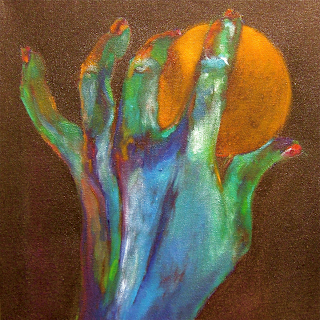
Wednesday, December 9, 2009
An Unconventional Holiday Tree

Sunday, November 29, 2009
Back From Morocco



Saturday, October 3, 2009
"Images with Multiple Meanings"






Sunday, September 20, 2009
Dialogues Within My Paintings

After several sketches, I take a photo one evening with light coming only from the lamp on the dressing table. Often dramatic lighting will enliven and begin the dialogue between the objects.
Voila! I see the beginning of a painting.


Sunday, September 13, 2009
Looking Forward to Fall 2009

In all the examples from previous summers the oil paintings are enclosed in panels of fusion glass that contain snippets of leaves and blossoms on a painted background. Everything in the fusion glass frame comes from the garden depicted in the painting.



“Nasturtiums 1” is the first of several oil paintings that I made recently of some plants I purchased for my decorative pots. I especially loved the legginess of the nasturtiums and was happy to have grabbed the last two left at Lynch’s one afternoon in early July. The dancing lines were inspired by the random marks that I made in my pencil sketches.
Sunday, August 30, 2009
Summer 2009

Is this a tomato only an artist could love? Heirloom tomatoes have a taste that is the essence of summer, but they are some of the ugliest tomatoes on the shelf according to market standards. The perfect tomato is genetically engineered to be round, uniformly deep red in color and has a skin tough enough to withstand rough handling, and yet.....
An heirloom tomato is pleasing to me as an artist because it is so outrageously odd. If I take an heirloom tomato as my subject in a painting its irrepressible color forces me to be bold with the entire composition. The fact that they inspire me has a lot to do with my transformation as an artist and the way that I paint today.

Early in my career as an illustrator I did a series of botanical watercolor paintings for the Del Monte Corporation. I was intrigued by the challenge of making my art look like an antique print done in the style of such masters as Pierre Redoute and Basilius Besler. I was also expected to be scientifically accurate and portray the botanical subjects as they had been engineered by Del Monte.
The difference between the perfect tomato in my botanical painting above and the tomato in Heirloom Supper below represents the evolution that has occurred in my work over the course of my career.. Now, with confidence in my painting technique, draftsmanship and use of color, I have taken a seminal leap and plunged into doing work that chronicles an emotional attachment to my subjects.



The third example Heirloom Supper, is a painting with quite a different approach. I have taken the table setting and the tomatoes as my starting point, but there is no doubt that something else is going on here besides a still life. I am hoping the painting does more than razzle-dazzle you with interesting colors as I tried to set up a narrative using my subjects as a sort of drama. The small tableau is a landscape of emotionally charged elements that retain their sense of normality even with their clashing hues, a combination of strangeness and familiarity.
It is a style that is analogous to the contradictory nature of an heirloom tomato. Even though the tomato sports unusual and brutal colors the fruit inside is heavenly. Try some summer . . .
Simple Heirloom Tomato Tart
1 package frozen puff pastry sheet, defrosted
1 T. extra-virgin olive oil
6 big ripe heirloom tomatoes, thinly sliced
1/4 c. chopped fresh basil
salt and freshly ground pepper
1 cup grated parmesan cheese
Roll out dough to 1/8-inch thickness. Place on cookie sheet and brush with olive oil. Sprinkle half the cheese over dough and place tomato rounds overlapping on top. Add salt and pepper. Bake for 30 minutes in preheated 425 degree oven. Sprinkle remainder of cheese and cook 20 minutes more until brown. Finish with basil and let cool 15 minutes before cutting in serving pieces. Yummy!
Friday, August 28, 2009
Winter 2009




Sunday, August 23, 2009
Spring/Summer 2008













-cop.jpg)







